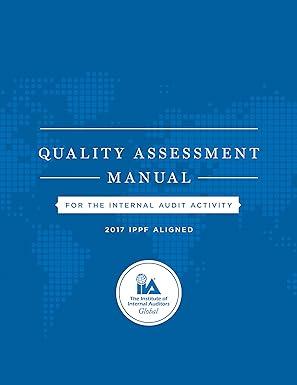Question
Before booking an entry, remember to evaluate the substance of each transaction/event. Do accounting standards require the event or transaction to be booked into your
Before booking an entry, remember to evaluate the substance of each transaction/event. Do accounting standards require the event or transaction to be booked into your companys accounting records? NOTE: All interest rates included in the transaction list are stated at an annual rate.
December
-
Wages earned from July 1st through December 31st was $480,000. Wages earned between Dec. 15th and Dec 31st amounting to $27,500 was not paid this until Jan 7th.
-
At the end of the year, $42,000 cash was paid to the local bank for the long-term note payable taken out on January 1, 2019. $38,000 of this was applied to the loan principal. The remaining amount was the accumulated interest due for 2019.
-
On December 31st, the marketable (trading) securities you purchased on September 23, 2019 transaction now has a fair market value of $134,000.
-
On December 31st, $480,000 depreciation expense for the year was calculated for equipment purchased before January 1, 2019.
-
On December 31st, you declare dividends of $.32 per share to be paid at a later date.
-
On December 31st, the utility bill was paid for the year. The amount was $66,000 and you paid in cash.
7
ACCY1 Accounting Fundamentals Group Project
-
On December 31st, you pay in cash recurring interest on the long-term note acquired prior to the year 2017. HINT: See prior year financial statements.
-
On December 31st, your company earned interest on the average 2019 cash balance which will be paid January 5th, 2020. The average interest rate for the year was 4.0%. Note: Compute the average cash using only the beginning and ending balance.
-
By December 31st, 85 of the prepaid service hours from March 20, 2019 were completed.
-
A count of office supplies indicated that $27,000 of office supplies had been used by December 31st.
-
Since the inception of your company, you have been able to collect 84% of your ending accounts receivable balance from customers that bought your product on account. Based on this information, adjust your allowance for bad debt account. NOTE: Use your 2019 ending accounts receivable balance to make this calculation.
Step by Step Solution
There are 3 Steps involved in it
Step: 1

Get Instant Access to Expert-Tailored Solutions
See step-by-step solutions with expert insights and AI powered tools for academic success
Step: 2

Step: 3

Ace Your Homework with AI
Get the answers you need in no time with our AI-driven, step-by-step assistance
Get Started


